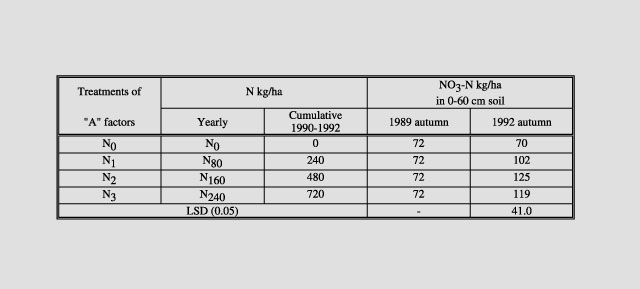
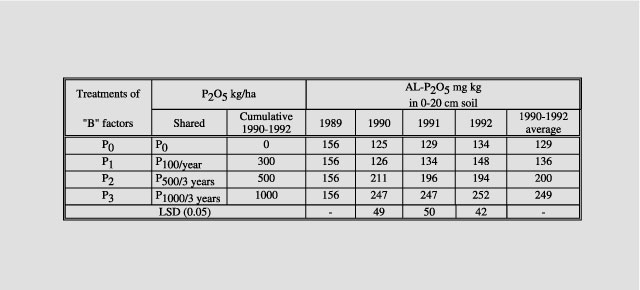

84
Influence of nitrogen supply and P and K levels of the soil on dry matter and nutrient accumulation of fiber hemp (Cannabis sativa L.)
Ildiko Ivonyi1 , Zolton Izsoki1 and Hayo M. G. van der Werf2
1Agricultural University of Debrecen College of Agricultural Water and Environmental Management, Crop Production Department, P. O. Box 3, H-5541 Szarvas, Hungary
2INRA, Unité d’Agronomie de Rennes-Quimper, ENSAR - 65, rue de Saint-Brieuc, F 35042 Rennes, France
Ivonyi, Ildiko, Zolton Izsoki and Hayo M. G. van der Werf 1997. Influence of nitrogen supply and P and K levels of the soil on dry matter and nutrient accumulation of fiber hemp (Cannabis sativa L.). Journal of the International Hemp Association 4(1): 82-87. A hemp (Cannabis sativa L.) fertilization experiment was conducted in Szarvas, Hungary, from 1990 to 1992. This paper reports the effect of nitrogen (N) application rate, soil phosphate (P) and soil potassium (K) levels on dry matter and nutrient accumulation. Four levels of N, P and K fertilizer were applied in a split-split plot design. Eleven regimes were selected to examine the development resulting from these treatments during the growing season. From the beginning of June to the beginning of August, the daily increase of above-ground dry matter was 0.17-0.19 t/ha. Intensive accumulation of N and K2O had begun in mid-May and lasted for a month. By the end of this phase, 79 % of total N uptake and 77% of total K2O uptake had occurred. The P2O5 uptake was constant during the period under examination. During the period of intensive nutrient uptake, the daily N uptake was 3-4 kg/ha and the daily K2O uptake was 3-6 kg/ha . The P2O5 uptake was 0.25-0.64 kg/ha during the period under examination. Nutrient supply influenced dry matter accumulation and the rate of N and K2O uptake. More importantly, the N supply increased the amount of dry matter formed and the rate of N, P2O5 and K2O increased uptake significantly at all times. At the time of maximum nutrient uptake, the amount of N incorporated into the plant was 142-256 kg/ha, the amount of P2O5 incorporated into the plant was 52-67 kg/ha, and the amount of K2O incorporated into the plant was 223-358 kg/ha, depending on the supply of nutrients. N fertilization increased the stem yield at all P and K supply levels of the soil up to 160 kg/ha N. The specific nutrient uptake for 1 t of above-ground dry matter of fiber hemp was 14.1 kg N; 3.5 kg P2O5 and 19.8 kg K2O.
Introduction
Fiber hemp (Cannabis sativa L.) is a fast growing annual crop which could potentially be used as a raw
material in the areas of textiles, paper products, foods and feeds, and energy applications. This plant has an important
agronomic potential in a great range of altitudes, climates and soils (Riddlestone and Desai 1994).
In Hungary, publications on hemp mainly cover cultivars, breeding, biological, ecological and general
practices for the crop (Mándy and Bócsa 1962, Ruzsányi 1967, Bócsa 1968, Horkay 1980). The literature on
fertilization is very limited. Csókás (1914) was the first in Hungary to test the dry matter and nitrogen (N),
phosphorus (P) and potassium (K) accumulation of fiber hemp. In his experimental work, he found that the maximum above-ground
dry matter yield was reached by July 30. The maximum dry matter yield was 14.9 t/ha, with 35 kg/ha N, 59
kg/ha P2O5 and
188 kg/ha K2O
fertilization. The maximum N uptake was 139 kg/ha reached by July 4, the maximum
P2O5 uptake
was 36 kg/ha, K2O
uptake was 273 kg/ha both reached at July 30. In Jakobey’s (1970) 3-year experiment, maximum above-ground dry matter yield
(including shed plant parts) and maximum N, P2O5 and K2O
uptake were reached simultaneously towards the middle or the end of July. At that time, the dry matter yield
was 7.3 t/ha, the N uptake was 103 kg/ha, P2O5 uptake was 47 kg/ha and the K2O
uptake was 209 kg/ha on a soil containing a moderate level of N, and P and a sufficient
level of K. In the 2 weeks after that, the dry matter decreased because of leaf senescence. In the experiments
by Csókás (1914) and Jakobey (1970), the formation of 1 t of above-ground hemp dry matter required respectively 9
and 14 kg of N, 2.4 and 6 kg of P2O5 and
18 and 28 kg of K2O.
According to the literature, the effect of N fertilization on the yield of fiber hemp is larger than the effect of
P or K. In the Netherlands, Poland and Italy, N fertilization rates between 150 and 240 kg/ha gave the highest
stem yields, whereas the highest bast fiber yields were obtained at N rates between 50 and 150 kg/ha
(Aukema and Friedrich 1957, Jaranowska 1964, Rivoria and Marras 1975, Marras and Spanu 1979).
Fertilization experiments have been conducted on different soil types in Hungary. The effect of N on stem
yield was positive up to 240 kg/ha, but above 100-150 kg/ha N, the bast fiber yield and the quality of the fibers
decreased (Nagy 1968, Ruzsányi 1970, György 1989). P fertilization alone did not increase stem yield (Nagy
1968). In the experiment of Ruzsányi (1970), P fertilization even decreased stem yield on low phosphorus soils. P
is needed for the realization of the N effect, but hemp is able to absorb the small quantity of P it requires from the
soil. According to these Hungarian experiments, the best fertilization rates for fiber hemp are: N 80-110 kg/ha,
P2O5 0-50
kg/ha, and K2O
50-200 kg/ha .
The literature suggests that the main nutrient factors affecting the yield of fiber hemp are N and K. Recent
data to be used as a basis for fertilizer recommendation are needed. This data should consider nutrient type and
quantity, soil supply, crop rotation and the effect of nutrient supply on yield and plant quality (van der Werf 1991). We
evaluated these factors and now report the effects of N, P, K supply (primarily N) on fiber hemp dry matter and N, P,
K accumulation, and stem yield.
Table 1. Applied treatments and their influence on the nutrient supply of the soil (Szarvas, 1990-1992)



Table 2. The influence of nutrient supply on highest and specific N, P2O5 , and K2O uptake of fiber hemp (Szarvas, 1990-1992)
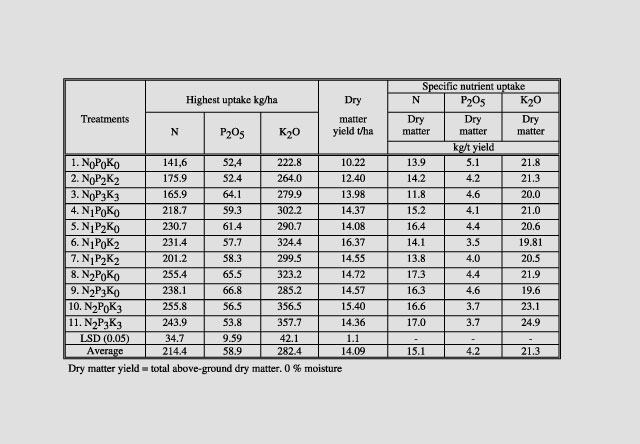
Materials and methods
The experiment was undertaken at Szarvas, in the
south-eastern part of Hungary from 1990 to 1992.
Soybean was grown prior to the hemp. The soil was a
chernozem meadow type which had a calcareous subsoil.
Four levels of N, P, K fertilizers were applied in a
split-split plot, randomized block design, with 64 treatments and three replications to determine the yield. In
the P and K treatments, the P1,
K1 levels
were aimed at maintaining a suitable soil nutrient level, whereas the P2,
P3 and
K2,
K3 were
aimed at developing different nutrient levels. The following eleven treatment regimes
were selected to examine the course of the dry matter yield, nutrient content and nutrient accumulation of
fiber hemp during the growing season: 1. N0P0K0;
2. N0P2K2; 3. N0P3K3;
4. N1P0K0; 5. N1P2K0;
6. N1P0K2; 7. N1P2K2; 8. N2P0K0;
9. N2P3K0; 10. N2P0K3;
11. N2P3K3. The treatments and their connection with
the soil nutrient supply are shown in Table 1.
The fiber hemp variety ‘Kompolti’ was planted in
the first week of April, at a seeding rate of 90 kg/ha and a row width of 12 cm. Total above-ground plant samples
(shed plant parts -primarily leaves- were not included) were taken every second week, six times during the
growing season, on 2 x 1 m of row (2 x 0.12 m 2 ). The distance between two sample areas was at least 2 rows.
After the fresh weight of the samples was determined, they were dried in air. Then the moisture content of the
air dried material was determined (at 105 C°, dried to constant weight) to allow the calculation of dry matter
yield. The N, P and K content of the dry matter was determined by photometer. Sampling took place on the
following dates: 15 and 30 May, 18 June, 02, 16 and 30 July in 1990; 30 May, 12 and 28 June, 15 and 30 July,
14 August in 1991; 13 May, 01, 16 and 29 June, 17 and 29 July in 1992.
At final harvest, we determined stem yield by
harvesting the entire 15.75 m 2 net
plot area. At the 11 treatment areas where samples had already been taken during
the growing season, we corrected for the sample areas. Stem yield is defined as stems + some inflorescences at
10 % moisture, which is the hand-over situation for hemp yield to the textile factory.
The specific nutrient uptake was determined from
the highest nutrient uptake during the growing season and from the highest dry matter yield (total above
ground plants: stems + leaves + inflorescences without shed plant parts, at 10 % moisture).
Chemical plant protection was only used against
the flea beetle (Psylliodes attenuata) at emergence.
In two of the three years, the annual precipitation
was less than the average of the previous 75 years (1990: 458 mm, 1991: 586 mm, 1992: 336 mm, and the
average for 1901-1975: 538 mm). The best year was 1991, when rainfall was above average, but
accumulated temperature and sunshine were below average.
The results were evaluated by analysis of
variance according to Sváb (1981).
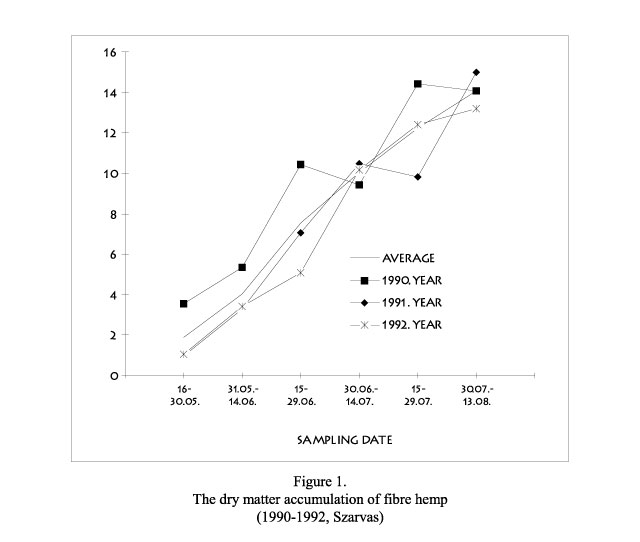
Figure 1. Dry matter accumulation of fiber hemp (1990-1992, Szarvas)
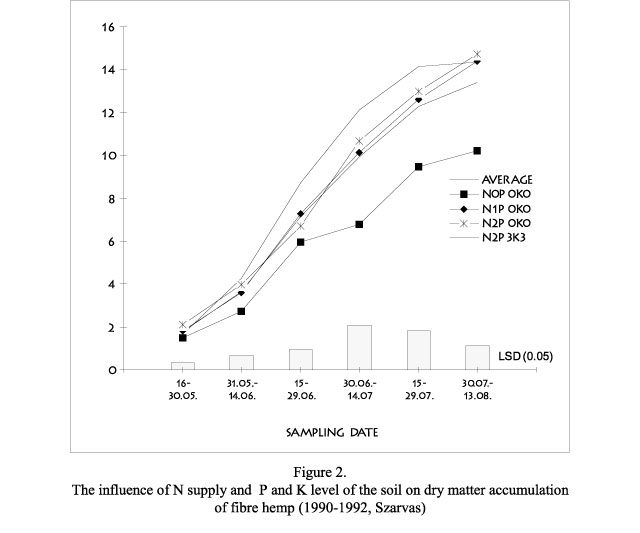
Figure 2. Influence of N supply and P and K level of the soil on dry matter accumulation of fiber hemp (1990-1992, Szarvas)

Figure 3. Effect of N fertilization and K level of the soil on N uptake of fiber hemp (1990-1992, Szarvas)
Results
Dry matter accumulation
The three-year average dry matter yield was 14.1
t/ha, the highest was 15.0 t/ha in a wet year (Fig. 1).
Dry matter accumulation happened at a slow rate in
the first two months of the growing season. Twenty nine
percent of the total weight had accumulated by the end of
May and the middle of June. Rapid growth followed for
two months to the beginning of August. During this period,
the daily increase of dry matter was 0.17-0.19 t/ha.
The typical accumulation curve has two peaks,
which happened in the two better years, 1990 and 1991.
This has been previously observed by Bredemann
(1945) and by Mándy and Bócsa (1965). This phenomenon
may be connected with the female plants’ energetic
development during and after male flowering. In
the dry year 1992, accumulation curves were continuous.
The dry matter accumulation was 20-58 %
higher
for N1 and
N2 than
the control at all sampling dates (Fig. 2). NPK fertilization (N2P3K3) resulted in 11-79 %
higher curves than in the control plots. There were no significant differences between N1 and
N2 treatments during the growing season. In the case of the last
harvest, there was no effect of P and K fertilization.
N, P2O5 and
K2O
uptake
On average, the maximum N uptake was 210
kg/ha by the 15-29 July sampling date (Fig 3). N1 and N2 fertilization
resulted in a longer N uptake season and a significant increase in the incorporation of N
compared to the control. The maximum N uptake for N1 was 219 kg/ha and for N2 it
was 255 kg/ha. These differences were statistically significant.
The rate of P2O5 uptake
was largely constant during the growing season (Fig. 4). On average, the maximum
of P2O5 uptake
was 58 kg/ha at the last sampling date. The time of maximum P uptake was earlier with
the N2P3K3 treatment. The maximum P uptake was 66
kg/ha at N2P0K0. This was significantly higher than the
control.
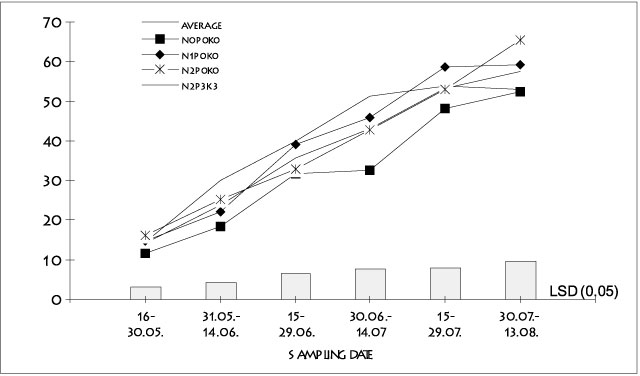
Figure 4. Effect of N fertilization and P and K level of the soil on P uptake of fiber hemp (1990-1992, Szarvas)
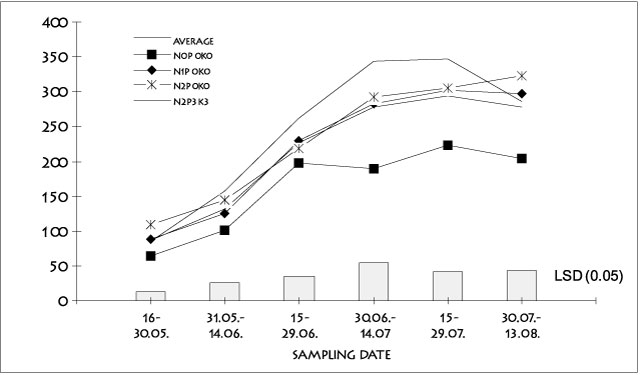
Figure 5. Effect of N fertilization and P and K level of the soil on K uptake of fiber hemp (1990-1992, Szarvas)
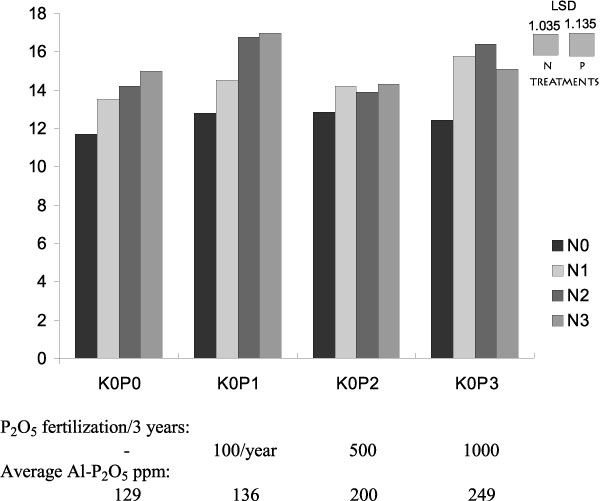
Figure 6. Effect of N supply and P level of the soil on stem yield of fiber hemp (1990-1992, Szarvas)
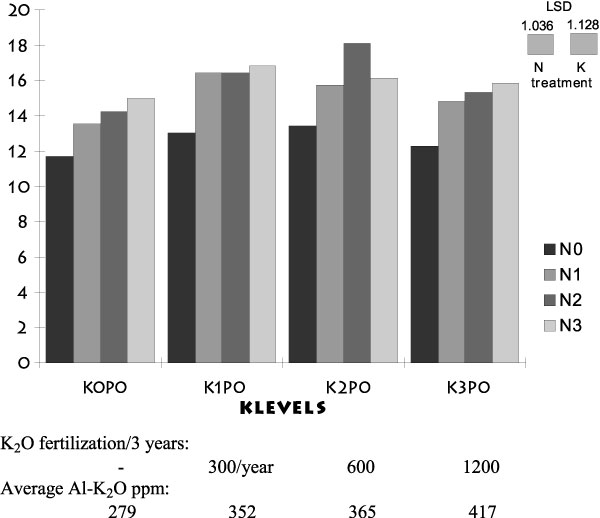
Figure 7. Effect of N supply and K level of the soil on stem yield of fiber hemp (1990-1992, Szarvas)
On average, the maximum K uptake was 294 kg/ha on 15-29 July (Fig. 5). N1 and N2 resulted in a significant increase of K incorporation compared to the control. The maximum K uptake was 337 kg/ha at the N2P3K3 level, significantly higher than for the other treatments.
Specific nutrient uptake
Specific N uptake varied from 11.8-17.3 kg/t
depending on the treatment (Tab. 2). For the highest dry matter yield, the N requirement for 1 t of dry matter was
14.1 kg for the N1P0K2 treatment. Our results are similar
to the earlier results of Jakobey (1970). For the production of one t of dry matter, the P2O5 requirement
varied from 3.5-5.1 kg and the K2O
requirement varied from 18.6-24.9 kg. Among the eleven selected treatments, the P2O5 and
K2O
requirements for 1 t of dry matter were smallest at the highest dry matter yield, which was obtained from the
N1P0K2 treatment (Tab. 2). For our control
treatment (N0P0K0), the specific P2O5 and
K2O
requirements were similar to those obtained by Jakobey (1970), but with a more balanced fertilization, the specific P2O5 and
K2O requirements decreased.
Stem yield
The effects of N fertilization at different soil P levels
As shown in Figure 6, N fertilization resulted in a
significant increase of stem yield at all P levels of the soil
as compared to the control. At P1 and P3 ,
80 kg/ha and 160 kg/ha of N, respectively, caused significant increases in stem yield, but a further increase in the amount of N had
no significant effect.
The P supply of the soil with no P fertilization in the 3 years of the experiment was between 125-134 ppm AL-P2O5. This P supply level is considered
sufficient on chernozem meadow soil for fiber hemp, because with the annual application of 100 kg/ha P2O5 (P1)
- which preserves the supply level - an 1-2 t/ha increase in stem yield can be achieved. At higher P levels, the stem yield did not
increase significantly. Our results support the findings of Nagy (1968) and Ruzsányi (1970).
The effects of N fertilization at different soil K levels
K fertilization resulted in a significant stem yield
increase up to the K1 or
K2 level,
as shown in Figure 7.
N fertilization resulted in a consistent increase in
yield at all K levels compared to the control. The highest increase was found at the K1 and
K2 levels.
K supply of the soil (without K fertilization) was between 240-300 ppm AL-K2O
in the experimental years. This K supply level is considered moderate on chernozem meadow soil
for fiber hemp, because with K fertilization at a better (K1-K2) supply level (350-360 ppm AL-K2O), a 1-3 t/ha
surplus can be achieved.
Discussion
Maximum above-ground dry matter yield is
achieved in the beginning and middle of August in
Hungary. In the experimental situation, the dry matter
yields were 14-15 t/ha on average, but they were about 10
t/ha without any fertilization. Yield increases (4.2-4.5 t/ha )
were achieved at 80 and 160 kg/ha N.
Maximum N and K uptake was reached at 15-29 of
July. The P uptake continued until August.
Over the averaged three years, among the 11
designated
treatments, the N1P0K2 treatment (80 kg/ha N on a
soil with 129 ppm AL-P2O5 phosphate
and 365 ppm AL-K2O potassium content) resulted in the
maximum dry matter yield: 16.4 t/ha. Thus, according to our findings, the specific nutrient uptake for 1 t fiber hemp dry matter was
14.1 kg N; 3.5 kg P2O5 and
19.8 kg K2O.
Among all the (64) treatments that they made it
possible to examine every combination of N-, P-, K- effects, the N fertilization increased the stem yield at all P and K
levels until 160 kg/ha N. The highest stem yield was 18.0 t/ha with 160 kg/ha N at a 129 ppm AL-P2O5 and
365 ppm K2O
soil supply level.
On chernozem meadow soil with a moderate humus
layer, 130-200 ppm AL-P2O5 and
350-360 ppm K2O
are adequate with 80-160 kg/ha N fertilization.
References